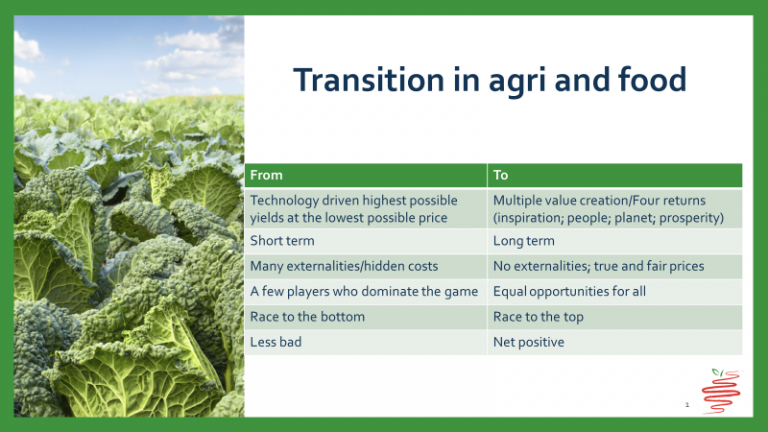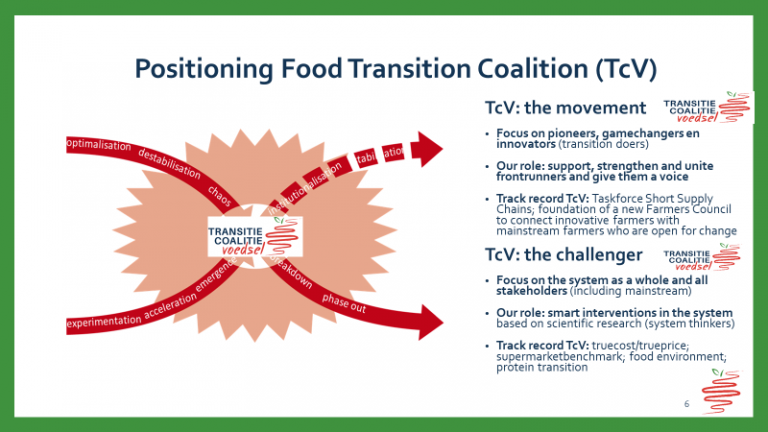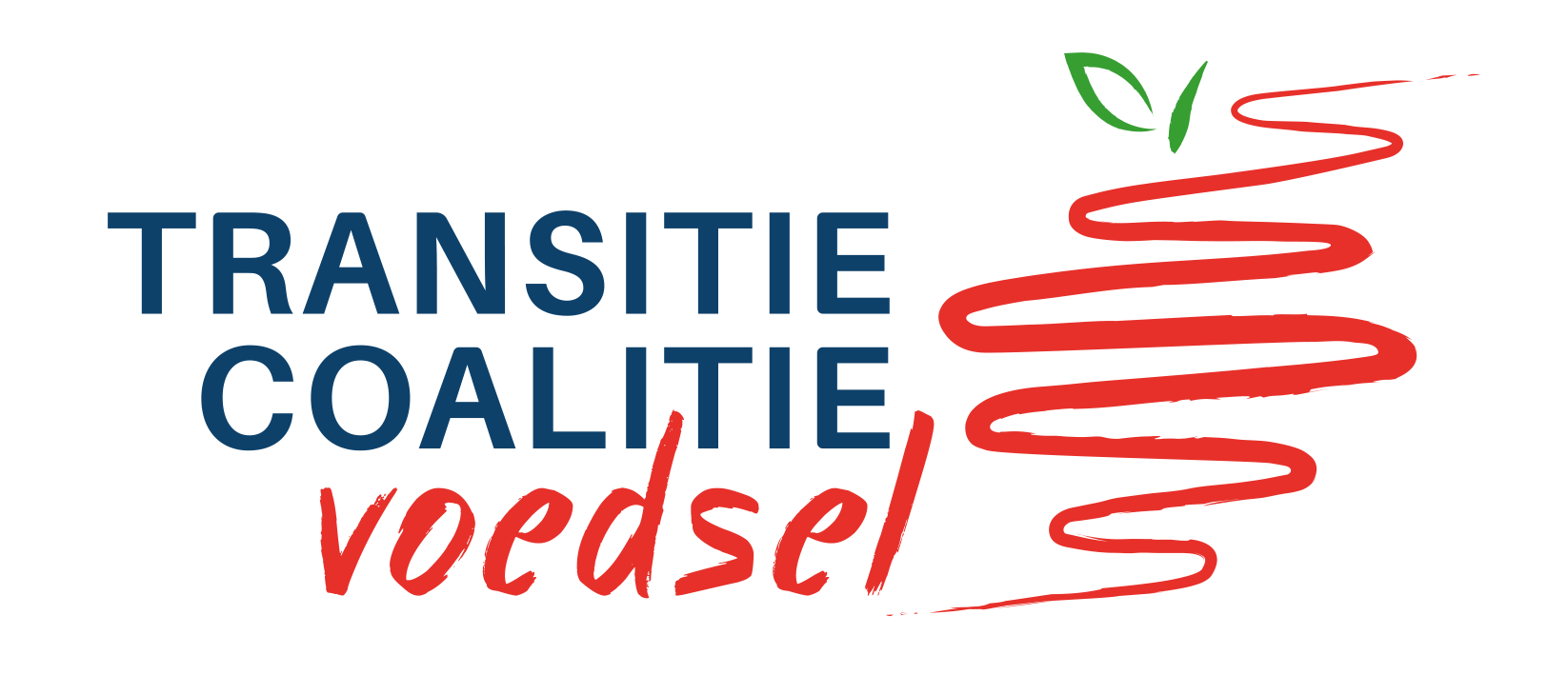By the day, the costs associated with the current agriculture and food (agrifood) system grow larger than the benefits. The damage done to the environment, climate, biodiversity and health of people and animals has by now passed far beyond the critical boundaries. On top of that, the perspectives for farmers continue to worsen. It is about time for a drastic change. This is the core of our vision document. Despite hopeful attempts from pioneers in the markets and new policy (such as that of circular agriculture from the Dutch ministry of agriculture and Farm to Fork from EU), the shift to a new system has only just begun. The current model is still stuck in old paradigms, in which volume, low prices and technology dominate the game.
This is the food transition coalition (TCV)
Why

Who are we
The Transitiecoalitie Voedsel (the Food transition Coalition) is a multi-stakeholder coalition of Dutch frontrunners in the field of agriculture, food, nature and health who strive to shape and speed up the transition. By now we are a coalition of approx. 200 peoples and parties, who are working on concrete solutions focusing on multidimensional value creation (4 returns) with underlying principles such as transparency, sustainability, health and fair price and incomes. That is why our motto is: A healthy life on a healthy planet. For everyone. With the Netherlands paving the way for the necessary transition in the global agrifood system. This motto can be summarized with ‘always sustainable and healthy’. It needs to take the place of the ‘no more hunger’ paradigm that has long dominated the European, and our national agrifood policy.
We are a collective of transition thinkers and doers who want to give direction to the agrifood transition. We are a guide, an inspirer and a challenger. We base ourselves on our 2017 vision document, which includes 9 points of departure or principles , a palette of inspiring future scenarios and diverse intervention strategies.
This is what makes our coalition unique. Our integral systems approach and our characteristics – the combination of thinking and doing, from analysis to action – together determine our added value and our ultimate impact.
Our input to the EU ‘from farm to fork strategy’
The food environment, a shift towards vegetables, and true cost true prices. These are the themes we as the Dutch Food Transition Coalition focused on in a submission on sustainable food systems in the EU. Read our proposals.

How we work
The transition model by the Dutch Research Institute for Transitions (DRIFT) and scientific insights in transition from New Foresight and Nyenrode University are our points of departure to determine our role and interventions.
A group of scientists headed by Frederike Praasterink (professor Future Food Systems at HAS University of Applied Sciences) guide us in our priorities and strategy. We work using a systems perspective, from which we determine two roles and intervention strategies for ourselves:
- Facilitating and strengthening the innovators from bottom-up (the upward sloping curve on the figure below). We call that the movement.
- Analyzing the whole system and intervening in all the systems players, in particular the mainstream players who determine the rules of the game now (amongst others: big business, retail, financial sector, and governments), to challenge them to stand behind the necessary transition (the total picture in the figure). We call that the challenger.
While in the first strategy we focus on making room for, bringing attention and giving voice to the innovators (supporting and strengthening), in the second we focus on analysis, knowledge, new rules for the game, other power (im)balances and interaction with large system players as the group that wants to change, but doesn’t know how (analyzing, connecting and influencing). For more detail see our roles later on.
We recognize that the market transformation corresponding to the transition will happen in phases, as shown in the scheme below from New Foresight.
Every phase asks for a different approach from the involved organisations. Our coalition will match our roles accordingly. This means that we will support frontrunners in the first phases of the transition (inception and competition) with knowledge, joining forces, visibility, and room to experiment. The innovators and markets that are further in the process (collaboration and insitutionalisation) are supported by engaging in partnerships (collaboration) and the solidification of new concepts in fitting law and rulemaking, or other binding agreements.

Those carrying our coalition are:
- Members (coalition members). Frontrunner companies, organisations and persons who explicitly connect to our vision document, and therefore our mission, vision, principles and actively engage with the relevant actions. Together these transition doers and thinkers form the basis of the TcV as multi-stakeholder coalition. By now this group is made up of approx. 125 paying members and 100 persons/parties that belong to our inner circle.
- (Secondary) Friends. Established companies and organisations that support the transition as viewed by TcV and the role and activities of TcV. But they still have work to do to act as example of our intended transition and cannot, or will not, (yet) take full responsibility for the standpoints and activities of TcV. Friends show their support for TcV by financial means (contribution to the Friends of TcV Fund), by public support (‘We are one the friends of TcV’), and by participation in specific TcV activities. By now Enza Seeds and Nyenrode University belong to the Friends of TcV group and conversations about joining are being conducted with tens of reputable companies/organisations.
- (Tertiary) Sympathizers (‘Fans’). Individuals and organizations who, by signing the TcV-Manifesto, endorse our mission, vision and longer-term goals. No recruitment has taken place yet.
- (Additional) Partners. To realise our strength and impact we work – thematically or on project basis – together with like-minded parties, like other networks (e.g. Green Protein Alliance; MVO Nederland; RIDLV; TAPP Coalition), NGOs (e.g. Hart Stichting; Voeding Leeft; Natuur & Milieu), experts or knowledge institutions (e.g. from research, education, organizational advice or technical).

What we do
What do we concretely do to speed up the transition?
- The challenger. The challenger is our strategic thinktank. She analyses and monitors the agrifood system and comes with concrete system interventions. Examples of interventions that we have put into motion: in collaboration with Questionmark we show with the supermarket benchmark how good/badly supermarkets score on the front of offering and marketing of healthy and sustainable food; with studies and proposals on the topic of true cost and true price we ensure a fairer playing field for sustainable and healthy products (recently we presented proposal for EU policy on this topic to Euro commissioner Frans Timmermans); with suggestions for a new approach in the government’s policy on knowledge and innovation we ensure that public resources go towards sustainable and healthy agriculture and food instead of largescale/industrial agricultural and food production. We have furthermore given concrete proposals for the transition from animal to plant-based proteins. We also have a ten-point plan in development for a healthy food environment that stimulates sustainable and healthy consumption.
- The movement. We support the pioneers and frontrunners with for example the following projects: joining forces among innovative farmer networks set up with the name Boerenwijsheid – now known as the Boerenraad (Farmers Council) – to give innovative farmers a stronger voice and to empower mainstream farmers to adapt their farms to ecological boundaries and the society around them; Taskforce Short Supply Chains (by now independently run) geared towards collaboration on data, logistics and outlets. Next to this TcV is a meeting place and breeding ground to prepare and execute frontrunners’ collective action. The four yearly plenary gatherings that we organize with and for the members serve to that end, as well as the diverse thematic groups and our digital communication channels. Our role as the movement and as challenger, alongside our priority projects are summarized in the following figure.

Action points
Our strategic action points are shown in the scheme that summarizes the contemporary agrofood system below.
Interaction
The Movement cannot go without the insights, believability, and authority of the Challenger. The Challenger cannot go without the impact and the influence of the Movement. They reinforce each other by drawing on each other’s strengths and on the expertise of the Knowledge cluster. Together they contribute to the development of values, language and insights of the agriculture and food system transition. Together they form the transition brain and conscience.
Organisation
There is a large amount of voluntary effort from the members.
Formally TcV is a Foundation. The Core team of quartermasters function as directory and is (ultimately) responsible for the activities. The core team is supervised by the Supervisory and Inspiration Board. Members and some external experts are part of the Impact Board, who support the core team in advice and action.
The Challenger is made up of a small fixed core of experts/transition thinkers who with the Knowledge element map out the research trajectory and interventions. This is supplemented by a flexible layer of experts with specialist knowledge and experience in (academic) research, business, government, partnership institutions, etc.
Financing
Our activities are funded by the following sources:
- Contributions from the members of the coalition (allocated by capacity)
- Perennial contributions from funds and other parties who support the role of TcV (e.g. DOEN Foundation)
- Contributions towards TcV from specific projects and programs
- Contributions from friends (via the Friends funds) and from fans (donations)
- Subsidy schemes that our coalition can call on.

